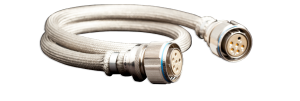Redefining EMI Shielding in High-Performance Systems
By Phil Lenk
Originally published with EverythingRF
In the rapidly evolving landscape of advanced electronics, with the drive toward electrification and space-bound innovation, electromagnetic shielding is no longer just a protective layer—it’s a strategic design element. From aerospace and defense to wearables and electric vehicles, systems today are smaller, faster, and more integrated than ever before. This integration has its drawbacks: greater vulnerability to electromagnetic interference (EMI) and an urgent need for shielding materials beyond traditional solutions.
The Evolving Challenge of EMI Shielding
EMI is a growing concern across every industry that relies on electronics. EMI occurs when unwanted electromagnetic energy disrupts an electrical circuit. Shielding with conductive or magnetic materials helps to minimize this effect, ensuring that signals reach their destination within the system with minimal degradation or interference.
Historically, copper or plated metal braids have been the industry standard for shielding cables and connectors. These materials are conductive, but also heavy, rigid, and corrosion prone. As systems become dense and operate at higher frequencies, they are more susceptible to interference and the downsides of copper and plated metal braids become more obvious.
Today’s systems must also meet tighter space constraints, stricter safety requirements, and light weighting targets than previous system iterations. Modern applications demand reduced weight, flexibility, durability, and multifunctionality; traditional copper braids, though reliable in static, controlled environments, cannot scale to meet these evolving demands. Their mass impacts everything from payload capacity in satellites to improve fuel efficiency in aircraft, their rigidity limits use in flexible systems, and their vulnerability to corrosion compromises long-term reliability.
Several key industry trends are pushing engineers to reconsider how they approach EMI shielding:
- Electrification of systems: Aircraft, vehicles, and even industrial infrastructure are going electric. This increases EMI threats, fault current risks, and the need for lightweight, conductive pathways.
- Miniaturization: As devices shrink in size but grow in complexity, shielding must be flexible and compact without sacrificing performance.
- Light-weighting: Weight reduction isn’t just about efficiency—it’s about mission success. Whether in space or aviation, unnecessary weight translates to additional costs.
- Harsh Environments: Systems are operating in more extreme conditions, enduring temperature swings, vibration, and chemical exposure. Shielding must not only protect signals but also survive the environment.
- Multifunctionality and Integration: A braid might need to shield, bear load, provide flexibility, and allow embedded sensing all at once.
- Composite Body Aircraft: Aircraft with composite bodies are becoming more and more popular. These vehicles require improved EMI shielding and lightning strike protection for their electrical systems while remaining lightweight and reducing radar signatures.
This developing landscape calls for advanced shielding materials that offer superior flexibility, significant weight reduction, enhanced durability, and improved resistance to corrosion. These solutions must not only mitigate EMI effectively but also contribute to overall efficiency and reliability. The future of electronic systems hinges on innovative shielding technologies that can rise to these diverse and challenging demands, enabling the next generation of high-performance systems.
Critical Applications Driving Advanced EMI Shielding Needs
Many applications are impacted by this need for EMI shielding. As electronic systems become more complex, compact, and powerful, the risk of EMI causing disruptions, data loss, or even catastrophic failures grows exponentially. The drive for improved EMI shielding isn’t confined to a single niche; instead, it’s a sweeping imperative impacting nearly every sector that relies on sophisticated electronics. This heightened threat means that engineers across many industries are actively seeking advanced EMI shielding solutions.
Space and Aerospace

In space systems, cables run through solar panel arms, scientific payloads, and structural harnesses where weight, thermal resilience, and flex endurance are critical.
In aerospace, weight savings translate directly to performance gains. Lighter weight components allow for additional fuel and sensors or for additional mission-critical hardware. EMI shielding is typically used for data buses, flight control wires, and even in-flight entertainment systems. For composite-bodied aircraft, the lack of natural conductivity necessitates reliable ground paths and lightning strike protection.
Military and Defense

For military applications, failure is not an option. Combat vehicles, rotorcraft, and portable communication systems require high shielding effectiveness and mechanical flexibility. Shielding must be lightweight and maintain EMI integrity under high vibration and motion while resisting corrosion from battlefield contaminants like sand, oil, and saltwater.
Robotics and Wearables
In industrial automation sectors like robotic arms or manufacturing lines, flexibility is key. These machines twist and bend thousands of times per day, which far exceeds the typical lifespan of traditional braids.
Smart textiles are also increasingly popular; wearables such as sensor-equipped garments, medical vests, and monitoring wraps need EMI shielding that resists corrosion from sweat and maintains signal integrity without impeding the textile’s ability to conform to the human body. For implantable and portable medical devices, EMI shielding is crucial for safe operation.
Electric Vehicles and Advanced Energy
Electric propulsion platforms from EVs to eVTOL aircraft generate high-frequency EMI and require meticulous shielding of power, battery, and control systems. The right EMI shielding and ground fault protection that also reduce overall system mass and improve safety are needed for these high-voltage cables, charging interfaces, and motor control systems. Shielding must also be resistive to automotive fluids and temperatures to meet the rugged demands of high-performance transportation platforms and next-generation vehicle architecture.
Marine, Industrial, and Specialty Systems
In maritime systems such as undersea remotely operated vehicles (ROVs) or naval radar systems, cables must resist not just EMI but also long-term corrosion.
As technology advances, EMI shielding is expected to be used in smart rigging ropes for industrial hoisting and cargo safety systems, where integrated conductive braids can detect tension changes or breaks in real time.
ARACON® Fiber: The Next Evolution in EMI Shielding
As the needs of applications transform, so must the shielding materials used. Enter ARACON® fiber from Micro-Coax, a lightweight, high-performance shielding braid made with metal-clad DuPont™ Kevlar® fibers. Designed to address the shortcomings of copper, ARACON is a versatile material providing superior EMI/RFI shielding, significant weight savings, excellent mechanical properties, and broad environmental resistance.
 The center of ARACON fiber is a filament constructed from DuPont™ Kevlar®, which is most notably used in bulletproof vests and flame-resistant gear. This fiber is then plated with silver or nickel to yield a lightweight, highly conductive, and solderable material. This results in a braid offering over 90% coverage and excellent shielding effectiveness performance superior to traditional copper braid. It is also extremely resilient, resisting chemicals, salt spray, thermal shock, and even long-term exposure to harsh aerospace fluids. Its thermal operating range of -110°C to +150°C, with short-term spikes to +200°C, ensures performance in both terrestrial and space-based platforms.
The center of ARACON fiber is a filament constructed from DuPont™ Kevlar®, which is most notably used in bulletproof vests and flame-resistant gear. This fiber is then plated with silver or nickel to yield a lightweight, highly conductive, and solderable material. This results in a braid offering over 90% coverage and excellent shielding effectiveness performance superior to traditional copper braid. It is also extremely resilient, resisting chemicals, salt spray, thermal shock, and even long-term exposure to harsh aerospace fluids. Its thermal operating range of -110°C to +150°C, with short-term spikes to +200°C, ensures performance in both terrestrial and space-based platforms.
ARAON fiber also simplifies installation, saving time and reducing the potential for cable damage. Its behavior is similar to a textile, and the fabric-like nature makes it easy to install in tight routing applications. The lack of mechanical memory means it doesn’t retain bends or kinks, making it ideal for dynamic or movement-intensive environments, and it can be cut with standard scissors or fabric tools, eliminating the need for specialized metal-cutting equipment.
ARACON fiber can be integrated with standard braiding equipment and crimped, soldered, or banded using conventional processes. This design flexibility allows engineers to created tailored solutions that maximize performance while simplifying routing, reducing harness stress, and improving overall system reliability.
The Future of EMI Shielding: Enabling Tomorrow’s Technology
As technology moves toward lunar habitats, autonomous air taxis, bio-integrated wearables, and satellite mega constellations, the need for flexible, high-performance shielding will only grow. This evolution underscores a critical shift from basic EMI protection to integrated, high-performance shielding solutions that actively contribute to a system’s overall efficiency, reliability, and lifespan.
Materials like ARACON fiber are supporting today’s innovations and enabling tomorrow’s breakthroughs. By offering superior EMI protection alongside critical advantages like significant weight reduction, enhanced flexibility, and extreme environmental resilience, advanced shielding materials are becoming indispensable. The future of advanced electronics, from critical aerospace systems to intricate medical devices, hinges on the widespread adoption of such innovative shielding solutions, ensuring signal integrity and operational reliability in an increasingly complex and electrified world.
Kevlar® is a registered trademark of DuPont. DuPont™ is a trademark of DuPont.
ARACON® is a registered trademark of Amphenol CIT.
Subscribe Now!
Interested in receiving email newsletters and other updates from Micro-Coax? Subscribe to receive our quarterly newsletter, product updates and more.
